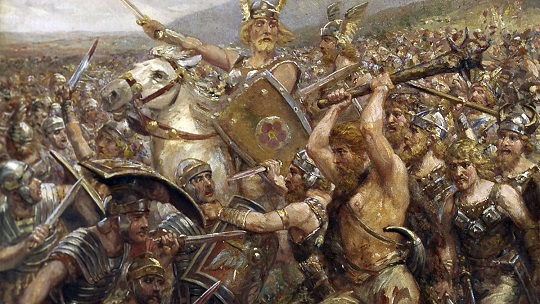
One of the most pivotal events in early German history—and a defining moment for the identity of the Germanic tribes—was the Battle of the Teutoburg Forest in 9 CE. At its heart was Arminius, a chieftain of the Cherusci tribe and former Roman ally, who orchestrated a stunning ambush that halted Rome’s expansion into Germania. This battle not only altered the balance of power in ancient Europe but also helped forge a collective sense of resistance and autonomy among Germanic peoples.
Background: Rome in Germania
By the late first century BCE, Rome had conquered Gaul and pushed into the lands east of the Rhine. Under Emperor Augustus, Roman governors sought to integrate the Germanic tribes into the empire—establishing roads, garrisons, and client rulers.
One of these rulers was Arminius, a Roman-trained commander from the Cherusci tribe. Educated in Roman military tactics and fluent in Latin, Arminius held Roman citizenship and served in the auxiliary forces. However, he secretly maintained loyalty to his people.
The Lead-Up to the Battle
Tensions rose as Publius Quinctilius Varus, the Roman governor of Germania, implemented harsh taxation and attempted to impose Roman law. This alienated many tribes, who saw Romanization as a threat to their independence and traditions.
Arminius, using his position and insight, united several rival tribes—an unprecedented move in Germanic politics. He fed Varus false intelligence about a rebellion in the northwest, luring the governor and his three legions—about 20,000 men—into the dense, unfamiliar terrain of the Teutoburg Forest.
The Ambush
The attack unfolded over three brutal days. Rain and mud slowed Roman progress, and narrow forest paths prevented defensive formations. Arminius and his allies used guerrilla tactics—hit-and-run attacks, barricades, and ambushes from the trees—to harass and dismantle the Roman columns.
By the end of the third day, the Roman legions were annihilated. Varus committed suicide, and the eagles of the legions—symbolic Roman standards—were captured, a humiliating loss for Rome.
“Quintilius Varus, give me back my legions!” — Emperor Augustus
This cry, according to ancient sources, captured the psychological blow the defeat dealt to the Roman world.
Aftermath and Historical Impact
The Battle of the Teutoburg Forest had massive consequences:
- Rome abandoned its plans to expand beyond the Rhine River.
- The region remained outside imperial control for centuries.
- Germanic tribes were emboldened, and Roman prestige suffered.
While Rome would retaliate in subsequent campaigns, it never fully conquered the Germanic heartlands east of the Rhine. The battle became a symbol of German resistance, celebrated centuries later during German unification.
The Legacy of Arminius
Arminius became a legendary figure, especially during the 19th century, when nationalists elevated him as a symbol of German unity and defiance against foreign domination. In German, he is often known as Hermann der Cherusker.
A massive monument, the Hermannsdenkmal, was erected near Detmold in the 19th century to commemorate his victory. It stands today as one of Germany’s most iconic historical monuments.
Archaeology and the Site
For centuries, the exact location of the battle remained unknown. In the 1980s and 1990s, archaeological discoveries near Kalkriese (in Lower Saxony) uncovered Roman armor, coins, and weapons—widely accepted today as the true site of the battle.
These findings provide crucial evidence of the battlefield’s scope and the tactics used by both sides, adding physical depth to what was once only known through Roman literary sources like Tacitus and Cassius Dio.
Broader Historical Significance
- The battle marked a turning point in Roman expansion and highlighted the limitations of even the most powerful empire of the time.
- It reinforced the regional independence of the Germanic world, setting the stage for medieval fragmentation and the eventual rise of the Holy Roman Empire.
- The themes of betrayal, resistance, and unity echoed in later eras of German history—from the Napoleonic Wars to World War II and postwar memory culture.
Arminius’ victory in the Teutoburg Forest is not just a tale of military cunning—it’s a foundational story in the long arc of German identity. His leadership showed that even a fractured group of tribes could challenge an empire. Today, the battle remains a symbol of cultural resilience and the enduring desire for self-determination.
Explore more about Arminius’ world in our articles on The Germanic Tribes, The Origins of the Germanic Peoples, and The Holy Roman Empire.
